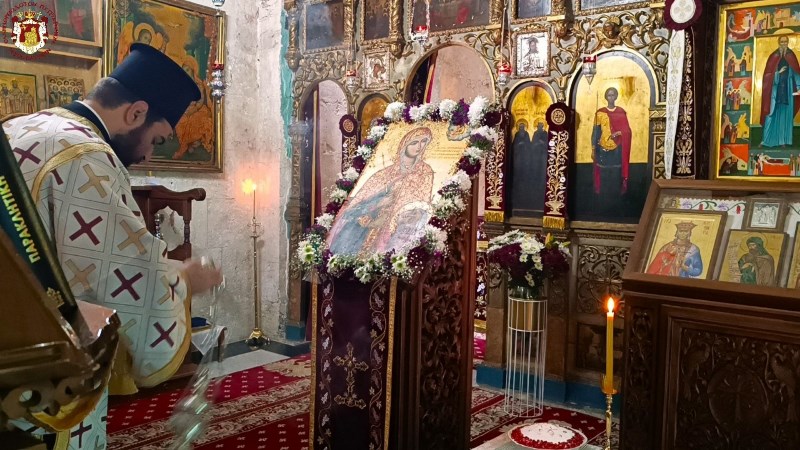Saint Nikitas the Great Martyr (15 September)


The Holy Great Martyr Niketas (Nikḗtas) was a Goth (a Germanic tribe). He was born and lived on the banks of the Danube River, suffering for Christ in the year 372. The Christian Faith was already spreading throughout the territory of the Goths at that time. Saint Niketas believed in Christ and was baptized by the Gothic bishop Theophilos, who participated in the First Ecumenical Council. Pagan Goths started to oppose the spread of Christianity, which resulted in a civil war.
After Fritigern, at the head of a Christian army, defeated the pagan Athanaric, the Christian Faith continued to spread among the Goths. The Arian bishop Ulfilas, the successor to Bishop Theophilos, created a Gothic alphabet and translated many priestly books into the Gothic language. Saint Niketas worked tirelessly among his fellow Goths to teach them about Christ. Through his personal example and inspired words, he brought many of them to the Christian Faith.
After his defeat, however, Athanaric managed to regroup his forces. He returned to his own country and regained his former power. Since he remained a pagan, he continued to hate the Christians and persecuted them, seeking revenge for the humiliation he had endured at their hands.
Saint Niketas had to contend against both visible and invisible enemies. In opposing these invisible enemies, he converted many pagans to Christ, and strengthened the faithful for the contest of martyrdom. Filled with zeal for God, the Saint denounced the persecutor Athanaric for his cruelty and impiety, because he subjected the Christians to severe torments.
Saint Niketas prevailed against both of these enemies. He trampled the devil underfoot, and defeated Athanaric in battle. The cruel tormentor was troubled because he was unable to convert Saint Niketas to his own impiety, and so he resolved to capture the Saint and put him to death.
Saint Niketas endured many tortures, and then he was thrown into a fire. Although his body was not burnt by the fire, he surrendered his soul to God, and his relics were illumined by a radiant light. By night, a Christian named Marianus, took the body of Saint Niketas, and buried it in Cilicia. Afterward, it was transferred to Constantinople. Part of the relics of the Great Martyr Niketas were later given to the monastery of Vysokie Dechani in Serbia. Thus Saint Niketas received an unfading crown of glory from Christ on September 15, 372.
We pray to Saint Niketas for the preservation of children from birth defects.
This Saint was of high birth among the Goths beyond the Danube River. He was taken by Athanaric, pagan ruler of the Goths, and after being tortured, was burned to death for his confession of Christ. According to some, this took place during the reign of Saint Constantine the Great; according to others, under the Emperor Gratian.
Nicetas was a Goth by birth. He was a disciple of Theophilus, Bishop of the Goths, who participated in the First Ecumenical Council [Nicaea 325 A.D.]. When the Gothic prince Athenarik began to torture Christians, St. Nicetas stood before the prince and denounced him for his paganism and inhumanity. Subsequently harshly tortured, Nicetas confessed his faith in Christ even more strongly, and prayed to God with thanksgiving. His mind was unceasingly raised up to God, and on his breast under his robe he bore an icon of the Most-holy Theotokos with the Pre-eternal Christ Child standing and holding the Cross in His hands. St. Nicetas carried this icon because the Holy Theotokos had appeared to him and comforted him. Finally, the torturer threw the soldier of Christ into the fire, where the holy martyr breathed his last, but his body remained untouched by the fire. His companion Marianus took his body from the land of the Goths (Wallachia and Bessarabia) to the town of Mopsuestia, in Cilicia. There, he built a church dedicated to St. Nicetas, and placed the miracle-working relics of the martyr in it. Nicetas suffered and was glorified in the year 372 A.D.
Apolytikion of Great Martyr Nikitas
Fourth Tone
Thy Martyr, O Lord, in his courageous contest for Thee received as the prize the crowns of incorruption and life from Thee, our immortal God. For since he possessed Thy strength, he cast down the tyrants and wholly destroyed the demons’ strengthless presumption. O Christ God, by his prayers, save our souls, since Thou art merciful.
Kontakion of Great Martyr Nikitas
Second Tone
Destroying the might of error by thy firm resolve, and taking the crown of vict’ry through thy sufferings, O Nikitas, namesake of vict’ry, thou rejoicest with angel-kind, and with them, O glorious one, thou ceaselessly prayest Christ God for us all.
Source: oca.org / goarch.org / westserbdio.org




